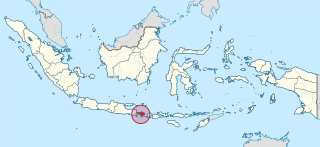
Bali is a province of Indonesia and the westernmost of the Lesser Sunda Islands. East of Java and west of Lombok, the province includes the island of Bali and a few smaller offshore islands, notably Nusa Penida, Nusa Lembongan, and Nusa Ceningan to the southeast. The provincial capital, Denpasar, is the most populous city in the Lesser Sunda Islands and the second-largest, after Makassar, in Eastern Indonesia. The upland town of Ubud in Greater Denpasar is considered Bali's cultural centre. The province is Indonesia's main tourist destination, with a significant rise in tourism since the 1980s. Tourism-related business makes up 80% of its economy.

An apsaras or apsara is a member of a class of celestial beings in Hindu and Buddhist culture. They are originally a type of female spirit of the clouds and waters, who later plays the role of a "nymph" or "fairy". They figure prominently in the sculpture, dance, literature and painting of many Indian and Southeast Asian cultures.

Balinese Hinduism is the form of Hinduism practised by the majority of the population of Bali. This is particularly associated with the Balinese people residing on the island, and represents a distinct form of Hindu worship incorporating local animism, ancestor worship or Pitru Paksha, and reverence for Buddhist saints or Bodhisattava.

Balinese mythology is the traditional mythology of the people of the Indonesian island of Bali, before the majority adoption of Hinduism.

Pendet dance a traditional dance from Bali, Indonesia, in which floral offerings are made to purify the temple or theater as a prelude to ceremonies or other dances. Pendet is typically performed by young girls, carrying bowls of flower petals, handfuls of which are cast into the air at various times in the dance. Pendet can be thought of as a dance of greeting, to welcome the audience and invite spirits to enjoy a performance. It is one of the oldest Balinese dance, although the current form was codified in the 1950s.

Tanah Lot is a rock formation off the Indonesian island of Bali. It is home to the ancient Hindu pilgrimage temple Pura Tanah Lot, a popular tourist and cultural icon for photography.
I Ketut Wiana was an Indonesian Hindu scholar. He was one of the foremost authorities on Agama Hindu Dharma.

Semar is a character in Javanese mythology who frequently appears in wayang shadow plays. He is one of the punokawan (clowns), but is in fact divine and very wise. He is the dhanyang of Java, and is regarded by some as the most sacred figure of the wayang set. He is said to be the god Sang Hyang Ismaya in human form.
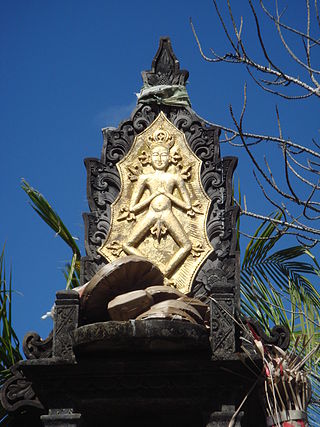
Achintya, also known as Sang Hyang Widhi Wasa and Sang Hyang Tunggal, is the Supreme God of Indonesian Hinduism, especially on the island of Bali. Achintya is equivalent to the metaphysical concept of Brahman of Indian Hinduism, and is the Supreme God in traditional wayang theatre. All gods, goddesses and existence are believed to be the manifestation of the Achintya in Balinese Hinduism.

Hyang is a representation of the supreme being, in ancient Java and Bali mythology. The spiritual entity can be either considered as divine or ancestral. The reverence for this spiritual entity can be found in the folk religions of Java and Bali, such as the Sunda Wiwitan, Kejawen, Kapitayan, and Gama Tirta. The realm where Hyang resides is called the Kahyangan, which is an Old Javanese term that literally means "the abode of Hyang", "part of Hyang", or "heaven".

A pura is a Balinese Hindu temple, and the place of worship for adherents of Balinese Hinduism in Indonesia. Puras are built in accordance to rules, style, guidance and rituals found in Balinese architecture. Most puras are found on the island of Bali, where Hinduism is the predominant religion; however many puras exist in other parts of Indonesia where significant numbers of Balinese people reside. Mother Temple of Besakih is the most important, largest and holiest temple in Bali. Many puras have been built in Bali, leading it to be titled "the Island of a Thousand Puras".

The mythology of Indonesia is very diverse, the Indonesian people consisting of hundreds of ethnic groups, each with their own myths and legends that explain the origin of their people, the tales of their ancestors and the demons or deities in their belief systems. The tendency to syncretize by overlying older traditions with newer foreign ideas has occurred. For example, the older ancestral mythology might be merged with foreign mythology, such as Hindu, Islam, or Christian biblical mythology.

Balinese cuisine is a cuisine tradition of Balinese people from the volcanic island of Bali. Using a variety of spices, blended with the fresh vegetables, meat and fish. Part of Indonesian cuisine, it demonstrates indigenous traditions, as well as influences from other Indonesian regional cuisine, Chinese and Indian. The island's inhabitants are predominantly Hindu and culinary traditions are somewhat distinct with the rest of Indonesia, with festivals and religious celebrations including many special foods prepared as the offerings for the deities, as well as other dishes consumed communally during the celebrations.

An Odalan is a Balinese village temple festival in Indonesia. It is an occasion when the Hindu village community comes together, invite the gods to visit them for three or more days, perform religious services together offering refreshments and entertainment. It is a periodic event, one that celebrates Balinese Hindu heritage and performance arts. The Odalan celebrations are a social occasion among Indonesian Hindus, and have historically contributed to the rich tradition of theatre and Balinese dance forms.

Balinese architecture is a vernacular architecture tradition of Balinese people that inhabits volcanic island of Bali, Indonesia. The Balinese architecture is a centuries-old architectural tradition influenced by Balinese culture developed from Hindu influences through ancient Javanese intermediary, as well as pre-Hindu elements of native Balinese architecture.
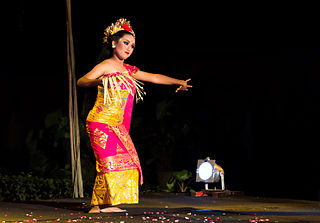
Panyembrama is a secular Balinese dance form designed by I Wayan Berata and first performed in 1971. It includes movements from several sacral Balinese dances, which it was intended to replace for performance in front of tourists.
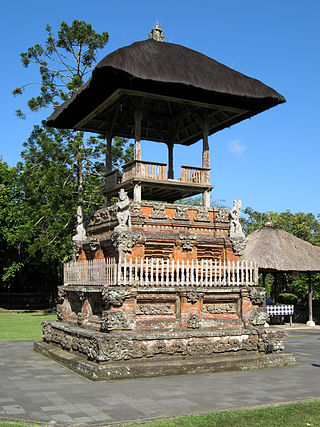
The bale kulkul or bale kul-kul is a Balinese pavilion where a slit-log drum is placed. It is essentially a drum tower or a watch tower. A bale kulkul can has a civic function, such as those used in villages as a mean of communication; or for religious function, an integral part of Balinese temple architecture.

A Meru tower or pelinggih meru is the principal shrine of a Balinese temple. It is a wooden, pagoda-like structure with a masonry base, a wooden chamber and multi-tiered thatched roofs. The height of Meru towers represent the Hindu Mount Meru. Meru towers are usually dedicated to either the highest gods of the Hindu pantheon, the local pantheon, or a deified person.

In a Balinese temple architecture, a Bhoma is a carved or formed grotesque which decorates certain parts in the Balinese temple complex. The statue is similar to the Javanese Kala, and was intended to protect the temple complex from malevolent spirits.
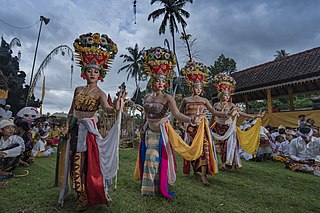
Rejang dance is a sacred Balinese dance, a sacrificial dance in which the girls offer themselves to the gods. It is usually held at the Hindu temple's of Klungkung Regency and Karangasem Regency in Bali, Indonesia. “Rejang” means “offering”, a dance to greet the gods that come down to the Earth. This dance is part of the sacred offering ceremonies, which all happen around about the same time on Bali's ceremonial calendar.



















